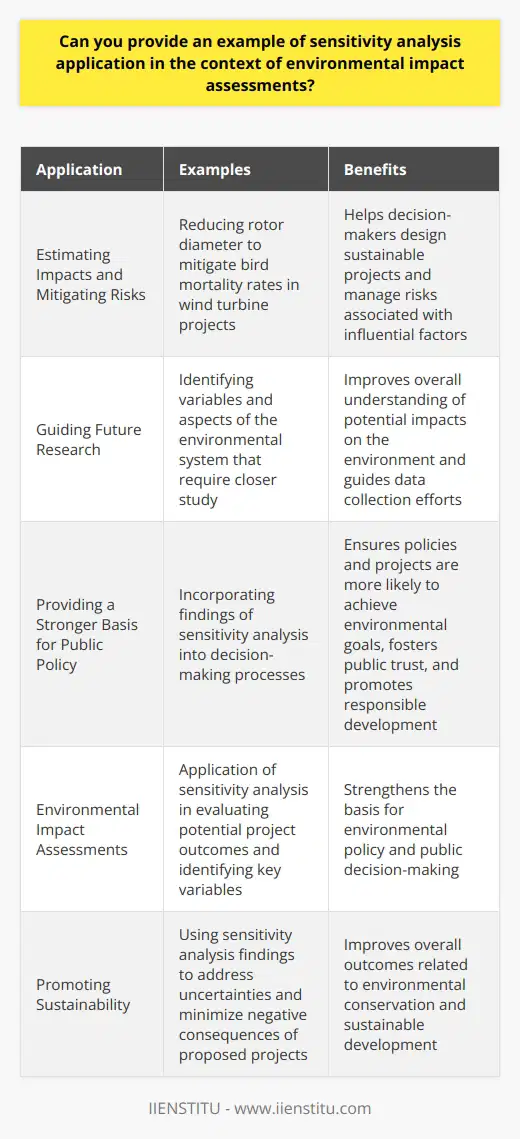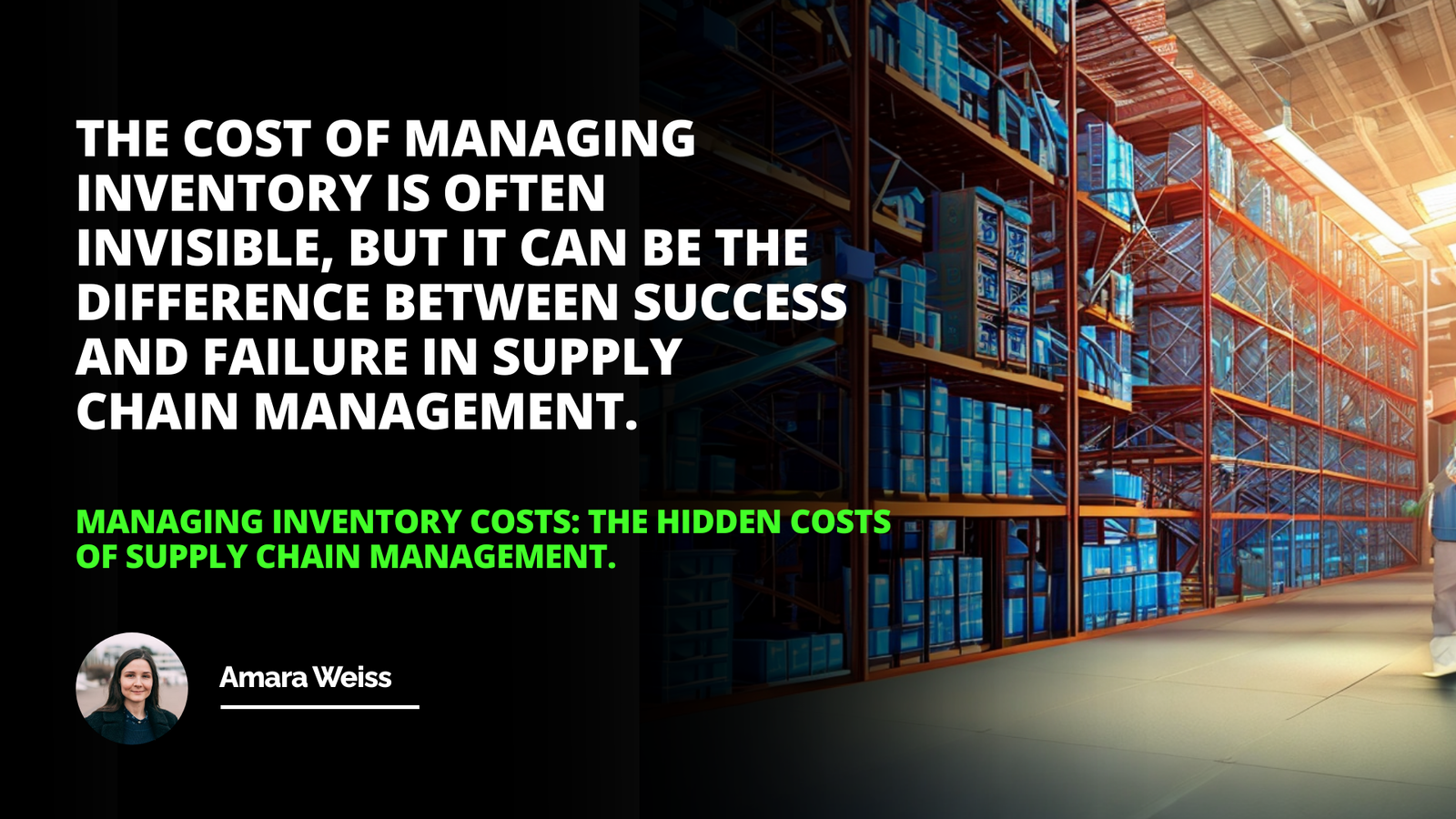
Introduction
You know, back when I was working in supply chain management, there was this time when we had to decide whether to ship a batch of electronic gadgets by ocean or air. The pressure was on; getting it wrong could cost the company thousands of dollars and upset our customers. That's when I truly appreciated the power of sensitivity analysis. In the world of logistics, making the right decision isn't always straightforward, especially when critical variables can change on a dime. But here's the thing: Sensitivity analysis can be our compass in these turbulent seas of decision-making.
Introduction
Overview of Sensitivity Analysis
Key Variables Examined
Findings of Sensitivity Analysis
Conclusion
Understanding Sensitivity Analysis
So, what exactly is sensitivity analysis? At its core, it's a method used to predict the outcome of a decision given a certain set of variables. In other words, it tells us how sensitive our decision is to changes in these critical factors.
Think of it like this: Imagine you're planning a picnic. You'd check the weather forecast, right? If there's a slight chance of rain, you might still go ahead. But if there's a high chance of thunderstorms, you'd probably reschedule. That's sensitivity analysis in everyday life—assessing how changes in one variable (the weather) affect your decision (to have a picnic or not).
The Importance in Decision Making
In the business world, especially in logistics and project management, sensitivity analysis becomes even more crucial. It allows companies to:
Evaluate risks: Understanding which variables have the most impact helps in mitigating potential risks.
Optimize decisions: By knowing how changes affect outcomes, companies can make more informed choices.
Allocate resources efficiently: It aids in determining where to focus efforts for maximum benefit.
Application in Logistics Management
Let's dive a bit deeper with an example from my own experience. We were tasked with shipping a new model of smartphones—let's call it Product A—from our manufacturing plant in Asia to retailers in the United States. The big question was: Should we ship by ocean or air?
The Ocean vs Air Dilemma
Shipping by ocean is significantly cheaper but takes longer—about four weeks. Air freight is faster, arriving in just a few days, but at a much higher cost. We had to consider not just the transportation cost ratio but also factors like inventory holding costs, demand forecasts, and the opportunity cost of capital.
Examining the Key Variables
In our sensitivity analysis, we focused on four key variables:
1- Transportation Cost Ratio: This is the cost comparison between air and ocean shipping.
2- Freight Cost of Product A: The actual cost to ship one unit of Product A.
3- Unit Cost of Product A: How much it costs to produce one unit.
4- Opportunity Cost of Capital: The potential benefits lost when capital is tied up in inventory during transit.
1. Transportation Cost Ratio
This ratio is pivotal. If air freight costs are, say, five times more than ocean freight, but we can sell the products faster and at a premium, is it worth it? We had to crunch the numbers and see how changes in this ratio would affect our bottom line.
2. Freight Cost of Product A
Shipping costs can fluctuate due to fuel prices, demand for freight space, and even geopolitical events. An increase in freight costs could tilt the scales in favor of one mode over another.
A well-crafted sensitivity analysis of logistics management can uncover insights that lead to greater efficiency and productivity.
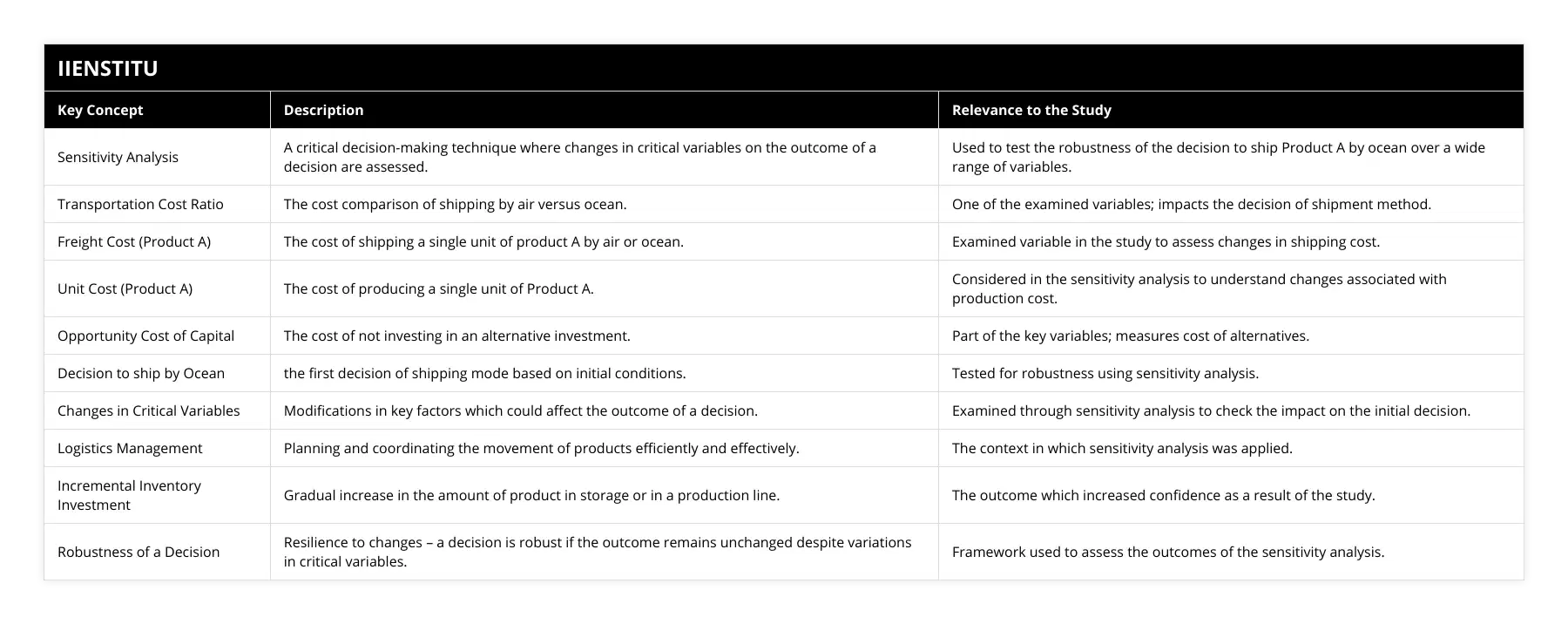
3. Unit Cost of Product A
If the production cost is high, holding a large inventory becomes riskier. Product obsolescence, especially in tech, can render expensive inventory worthless.
4. Opportunity Cost of Capital
Money tied up in inventory is money not used elsewhere. We had to consider what else we could do with that capital—maybe investing in marketing or R&D.
Findings of the Sensitivity Analysis
After examining these variables, we found something interesting. Despite fluctuations in each variable, the initial decision to ship by ocean remained solid. Even if the interest rates rose, or if we slightly miscalculated the cost of Product A, shipping by ocean was still the most cost-effective option.
Robustness of the Decision
This robustness gave us confidence. It meant that our decision was not just a shot in the dark but was backed by thorough analysis. We weren't just crossing our fingers and hoping for the best.
Implications for Logistics Management
Understanding this allowed us to:
Plan better: Knowing that minor changes wouldn't derail our decision helped in long-term planning.
Communicate effectively: We could assure stakeholders that the decision was sound.
Allocate resources wisely: Funds saved on shipping could be allocated elsewhere.
The Role of Sensitivity Analysis in Project Management
In project management, especially when employing the critical path method project management strategy, sensitivity analysis is invaluable. The critical path method (CPM) helps identify the sequence of crucial steps that determine the minimum project duration. But what happens when variables within those steps change?
Managing Uncertainties and Risks
Sensitivity analysis allows project managers to:
Identify which tasks are most sensitive to delays.
Assess how changes in resources affect project timelines.
Develop contingency plans for unexpected changes.
Aligning with the Critical Path Method
By understanding the sensitivity of each task, managers can focus on:
Prioritizing critical tasks that, if delayed, impact the entire project.
Allocating buffers where necessary.
Optimizing resource allocation for maximum efficiency.
Personal Reflections on Sensitivity Analysis
I recall another instance when sensitivity analysis saved the day. We were launching a new product line, and market conditions were volatile. Competitors were entering the market, and raw material costs were rising. Using sensitivity analysis, we tested various scenarios:
What if material costs increased by 10%?
How would a 5% drop in market demand affect us?
What if a key supplier failed to deliver on time?
By analyzing these possibilities, we weren't caught off guard when one of our suppliers had a delay. We had already planned for it, and as a result, our launch went smoothly.
Practical Steps to Implement Sensitivity Analysis
For those looking to incorporate sensitivity analysis into their decision-making, here's a simple guide:
1- Identify Key Variables: List out all the factors that could impact your decision.
2- Gather Accurate Data: Ensure the information you're using is up-to-date and reliable.
3- Use Appropriate Tools: Spreadsheets, statistical software, or specialized tools can aid in calculations.
4- Test Different Scenarios: Change one variable at a time to see its impact.
5- Interpret the Results: Focus on variables that have the most significant effect.
6- Develop Contingency Plans: For high-impact variables, have backup strategies.
The Broader Impact on Business Strategy
Sensitivity analysis doesn't just apply to logistics or project management. It's a critical component in:
Financial forecasting
Risk management
Strategic planning
Incorporating into Company Culture
Encouraging a mindset where decisions are backed by sensitivity analysis can lead to:
Better risk mitigation
More agile responses to market changes
Enhanced stakeholder confidence
Conclusion
In the ever-changing landscape of business, being prepared for uncertainties is not just an advantage—it's a necessity. Sensitivity analysis equips us with the knowledge to make informed decisions, even when variables are in flux. By understanding how changes impact outcomes, we can navigate the complexities of logistics, project management, and beyond with confidence.
So next time you're faced with a tough decision, consider taking a page out of the sensitivity analysis playbook. It might just save you a headache or two.
References
Hesse, M. (2008). The City as a Terminal: The Urban Context of Logistics and Freight Transport. Ashgate Publishing.
Chopra, S., & Meindl, P. (2013). Supply Chain Management: Strategy, Planning, and Operation. Pearson Education Limited.
Kerzner, H. (2009). Project Management: A Systems Approach to Planning, Scheduling, and Controlling. John Wiley & Sons.
Winston, W. L. (2004). Operations Research: Applications and Algorithms. Thomson Brooks/Cole.
Taha, H. A. (2007). Operations Research: An Introduction. Pearson Prentice Hall.
Galloway, P. D. (2006). Scheduling and Cost Control: Using PERT and CPM Techniques. RSMeans.
Key Takeaways
Sensitivity analysis helps in evaluating how changes in critical variables affect decisions.
It's essential in logistics management for decisions like choosing between ocean and air freight.
Incorporating sensitivity analysis enhances the robustness of decisions and planning.
It's closely tied to the critical path method project management strategy in handling uncertainties.
Practical implementation involves identifying variables, gathering data, and testing scenarios.
It has a broader impact on financial forecasting, risk management, and strategic planning.
Embracing sensitivity analysis has been a game-changer in my career, and I believe it can be for you too. After all, in the business world, it's better to be safe than sorry!
Related Course
For those interested in diving deeper, consider studying "Operations Research" or "Advanced Project Management" to enhance your understanding of these concepts.
Frequently Asked Questions
What is the purpose of sensitivity analysis in logistics management?
Sensitivity analysis is an essential tool used in logistics management to evaluate the impact of changes in the parameters of a model. It identifies potential risks or unexpected outcomes that could occur if specific variables are changed. By running sensitivity analysis, businesses can gain insights into what decisions are likely to be most beneficial and which should be avoided.
Sensitivity analysis is a part of the decision-making process in logistics management, as it helps identify the most important factors that could affect the success or failure of a decision. For example, a business might want to determine which aspects of its logistics operations are most sensitive to market or environmental changes. The business can adjust its operations accordingly by understanding the most susceptible variables.
In addition to helping identify the most critical variables, sensitivity analysis can also place any unknown risks that could arise from changes in certain variables. This allows businesses to plan for potential hazards and develop mitigating strategies.
Sensitivity analysis is also helpful in evaluating the impact of any changes that have already occurred in the logistics operations. By understanding the potential impacts, businesses can make more informed decisions about future changes and how they could affect their operations.
Overall, sensitivity analysis plays a vital role in logistics management by helping businesses identify which variables are most important and which should be avoided. Companies can make more informed decisions and develop strategies to mitigate potential risks by understanding these variables.
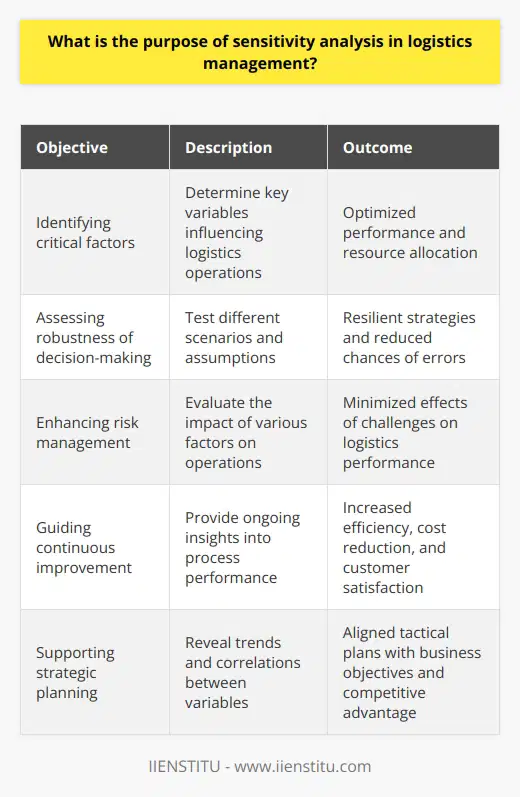
What are the key variables examined in sensitivity analysis for logistics management?
In logistics management, sensitivity analysis is a helpful tool for considering the key variables that can significantly affect a system. It allows for identifying the factors that may have the most influence on the system, as well as assessing the potential effects of changes in these factors. In this article, we will discuss the key variables that are typically examined in sensitivity analysis for logistics management.
The most critical variables considered in sensitivity analysis for logistics management are those related to the supply chain. These include inventory levels, transportation costs, and lead times. Other variables such as customer demands, customer satisfaction, demand forecasts, and supplier performance are also considered.
Inventory levels are a crucial variable in sensitivity analysis for logistics management because they can significantly affect the flow of goods through the supply chain. High inventory levels can lead to decreased customer satisfaction and cash flow due to the need to maintain significant stock levels. On the other hand, low inventory levels can lead to increased production costs and delays in customer deliveries.
Transportation costs are also an essential variable in sensitivity analysis for logistics management. High transportation costs can lead to an increase in overall supply chain costs and can also lead to delays in customer deliveries. Conversely, lower transportation costs can lead to a decrease in overall costs and improved customer satisfaction.
Lead times are also a key variable in sensitivity analysis for logistics management. Lead times can significantly affect the cost and efficiency of the supply chain, as well as customer satisfaction. Long lead times can lead to an increase in costs and a decrease in customer satisfaction. Conversely, shorter lead times can lead to a decrease in costs and an increase in customer satisfaction.
Customer demands, customer satisfaction, demand forecasts, and supplier performance are essential variables in logistics management sensitivity analysis. Customer demands and customer satisfaction can significantly impact the supply chain's cost and efficiency, as well as the overall customer experience. Demand forecasts, on the other hand, can allow for more accurate planning and better resource utilization. Lastly, supplier performance can significantly impact the supply chain's cost, efficiency, and customer satisfaction.
In conclusion, sensitivity analysis for logistics management is a helpful tool for considering the key variables that can significantly affect the system. The most critical variables typically examined in sensitivity analysis for logistics management are those related to the supply chain, such as inventory levels, transportation costs, and lead times. Other variables such as customer demands, customer satisfaction, demand forecasts, and supplier performance are also considered.
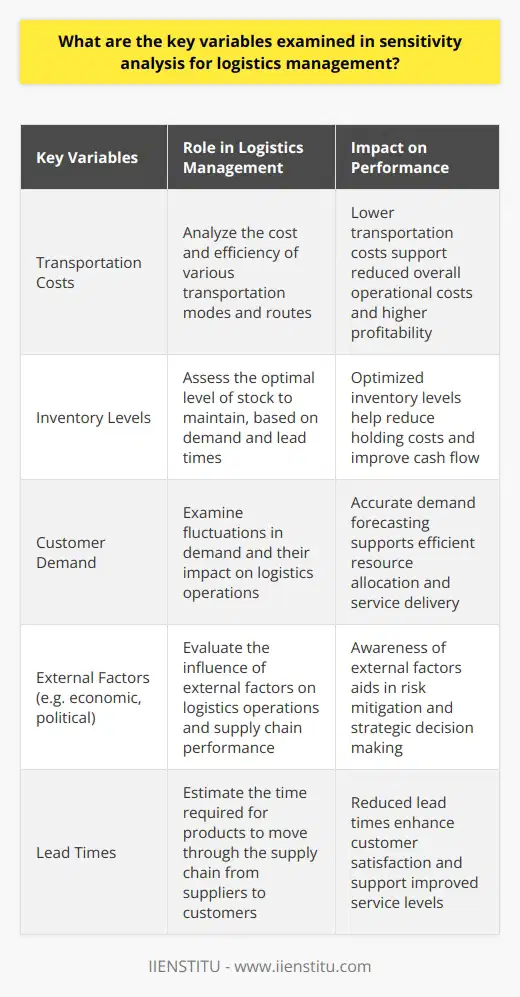
What are the findings of sensitivity analysis for logistics management?
Sensitivity analysis is a valuable tool for logistics managers to evaluate the impact of changes on their operations. This analysis helps managers understand the financial and operational impacts of potential decisions and allows them to make informed decisions about their operations. The findings of sensitivity analysis for logistics management can provide valuable insights into the potential impacts of decisions on costs and operational performance.
Sensitivity analysis for logistics management allows managers to identify what changes in a system or process can lead to the most significant cost savings or operational efficiency. By evaluating the impacts of changes in different areas, such as inventory levels, warehouse space, transportation costs, and the use of third-party logistics services, managers can identify the most impactful changes to their operations. This analysis can help logistics managers better understand the trade-offs between cost and performance and determine which changes will benefit their operations most.
In addition to identifying the most cost-effective changes, sensitivity analysis can help managers identify areas of risk in their operations. By evaluating the impacts of changes to the system or process, managers can identify areas of the procedure that may be more prone to disruption and identify potential measures to reduce the risk. This analysis can also help managers identify areas of their operations that may need additional resources or changes to improve performance and reduce risk.
Sensitivity analysis can also be used to evaluate the potential impacts of changes to customer service. By assessing the impacts of changes to service levels, delivery times, and customer satisfaction, managers can identify areas of the operation that need improvement or changes to meet customer expectations. This analysis can also help identify areas where customer service can be enhanced to improve performance and customer satisfaction.
Overall, sensitivity analysis for logistics management is a valuable tool for managers to evaluate the impact of changes on their operations. This type of analysis can help managers identify potential cost savings, risk areas, and improvement opportunities in customer service. By understanding the potential impacts of changes to their operations, managers can make informed decisions about their operations and better manage their business.
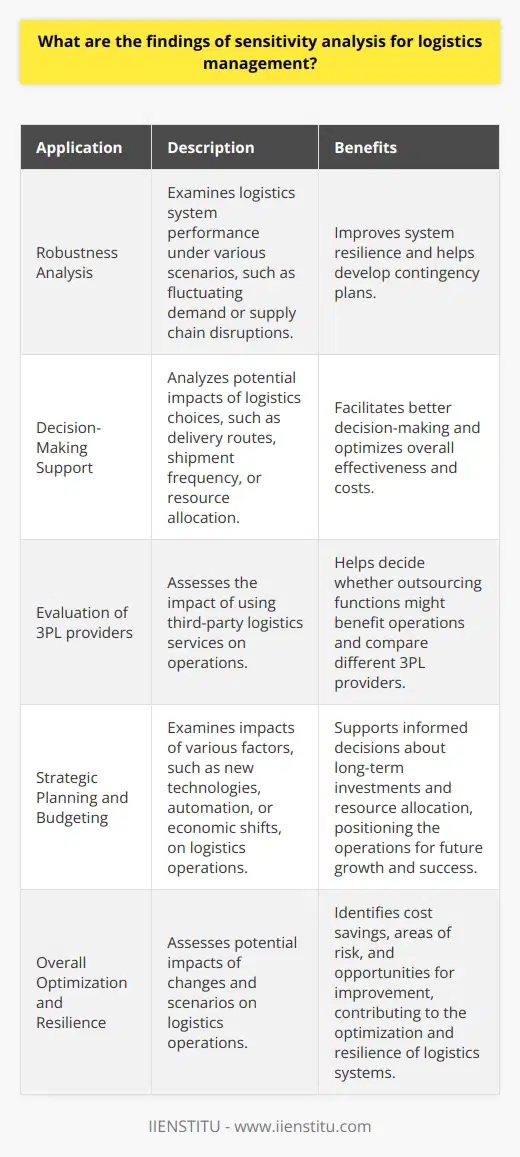
What are the main steps involved in conducting sensitivity analysis?
Defining Objectives and Scope
The first step in conducting sensitivity analysis involves clearly defining the objectives and scope of the study. This includes specifying the decision-making context, the key issues to be addressed, and the level of detail required for the analysis.
Selecting Variables and Parameters
Next, the analyst must identify the key input variables and parameters that may have a significant impact on the study's results. These factors should be chosen based on their relevance to the decision-making context and their potential to affect the model's output.
Defining Uncertainty Ranges
For each selected variable and parameter, the analyst must specify a range of plausible values that encompasses the uncertainty related to these factors. This can be based on expert judgment, historical data, or other sources of information.
Identifying Appropriate Model
The analytical model used for the sensitivity analysis should be appropriate for the problem or decision at hand, and it should be as accurate and robust as possible.
Performing Sensitivity Calculations
Once the model is selected, the next step is to perform a series of calculations or simulations that explore the impact of varying the input variables and parameters within their specified uncertainty ranges. This can involve multiple methods, such as one-at-a-time (OAT) sensitivity analysis, global sensitivity analysis, or design of experiments (DOE).
Interpreting Results
After completing the sensitivity calculations, the final step is to interpret the results, comparing the relative importance of different input variables and parameters on the model's output. This can help decision-makers identify critical factors for further study, prioritize interventions, or understand trade-offs between different options.
In conclusion, conducting a sensitivity analysis involves several significant steps, including defining objectives and scope, selecting important variables and parameters, defining uncertainty ranges, applying an appropriate model, performing sensitivity calculations, and interpreting the results. By following these steps, analysts can assess the robustness of a model and provide valuable insights to support evidence-based decision-making.
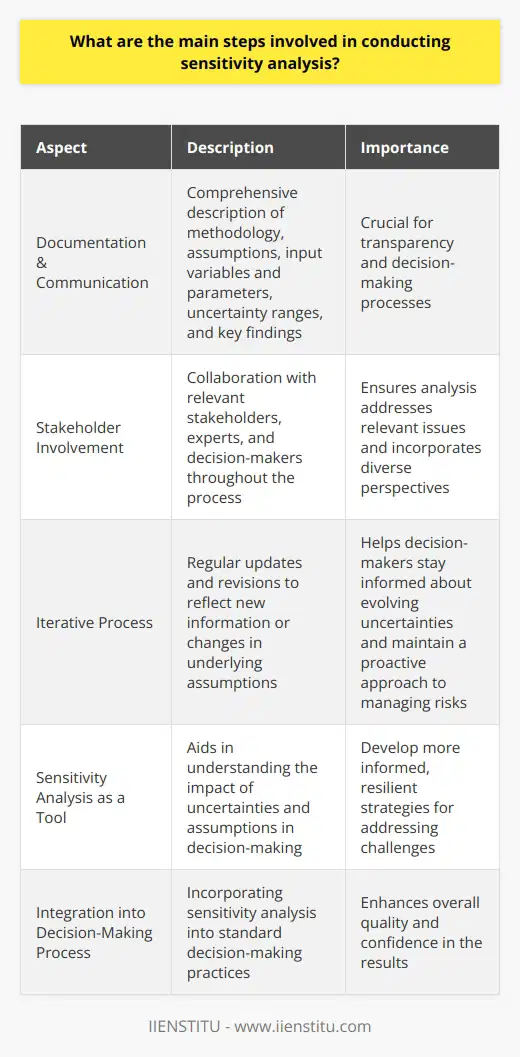
How does sensitivity analysis aid in decision-making within various industries?
Sensitivity Analysis in Decision-Making
Sensitivity analysis plays a crucial role in decision-making within various industries by providing valuable insights into the implications of uncertainty. By identifying key variables and assessing how changes in these variables can impact the overall outcome, sensitivity analysis enables decision-makers to better understand the risks and potential benefits associated with specific choices.
Understanding Uncertainties
In many industries, decisions need to be made based on models and forecasts that incorporate numerous assumptions about the future. Sensitivity analysis helps businesses explore how changes in these assumptions can influence the outcomes. It exposes possible vulnerabilities in the model and helps determine whether the decision is still valid even when key variables change.
Optimizing Resource Allocation
Resource allocation is a critical aspect of decision-making, with businesses aiming to maximize their returns by investing in the most promising opportunities. Sensitivity analysis aids in determining which projects or investments are more likely to yield high returns, despite changing market conditions or other uncertainties. By offering insights into which variables have the most significant effects on outcomes, decision-makers can make more informed choices in allocating resources.
Evaluating Alternative Scenarios
Sometimes, businesses face difficult decisions where multiple alternatives seem viable. Sensitivity analysis can provide valuable information that enables decision-makers to compare and contrast different options. By exploring the outcomes associated with varying assumptions, decision-makers can determine which alternative offers the most resilience and potential for success in the face of changing circumstances.
Reducing Risks
Risk management is a critical component of decision-making in every industry. Sensitivity analysis allows businesses to identify and quantify the potential risks associated with their decisions. By understanding how the outcome of a decision might fluctuate under different scenarios, businesses can develop strategies that minimize those risks and safeguard their interests.
Enhancing Confidence in Decisions
Finally, sensitivity analysis can boost confidence in decision-making processes by demonstrating that due diligence has been exercised in considering different outcomes. By showing that a decision has been carefully analyzed under various assumptions, decision-makers can be more confident in their choice and better justify the rationale behind their decision to stakeholders.
In conclusion, sensitivity analysis is an essential tool for decision-making within various industries. By helping businesses understand uncertainties, optimize resource allocation, evaluate alternative scenarios, reduce risks, and enhance confidence in their decisions, sensitivity analysis contributes to a more robust and informed decision-making process.
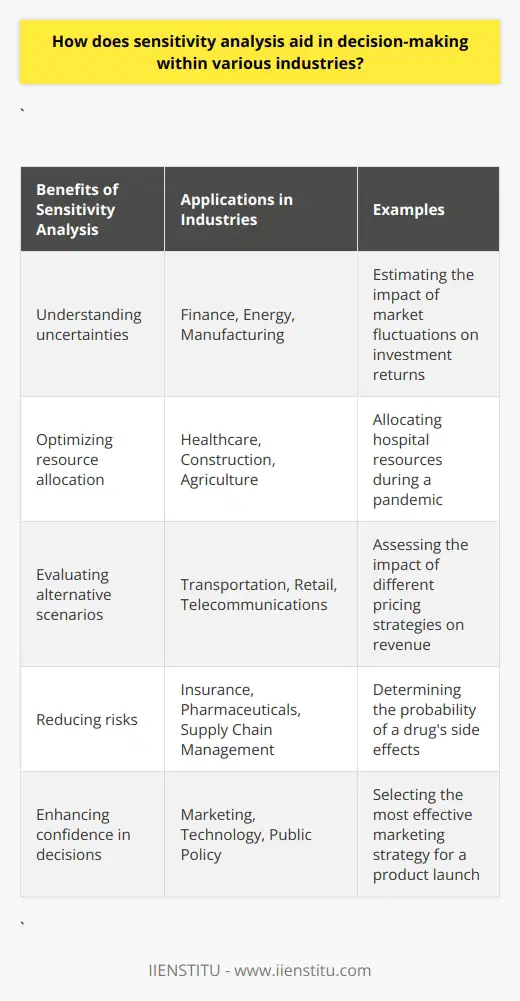
Can you provide an instance where sensitivity analysis was used to mitigate risks in a business setting?
Application of Sensitivity Analysis
An instance where sensitivity analysis was used to mitigate risks in a business setting can be observed in the case of a real estate development project. In this scenario, a real estate development company was evaluating the financial feasibility and potential risks of a new venture by constructing a housing complex.
Assessing Key Variables
The development company employed sensitivity analysis to identify the key variables that could significantly impact the project's financial performance, such as construction costs, sales prices, and interest rates. By understanding the potential effects of these variables, they gained insights into the possible outcomes and their associated risks under different scenarios.
Scenario Analysis Strategy
Consequently, the development company developed a scenario analysis strategy, which involved assessing the project's net present value (NPV) under various assumptions. This allowed them to pinpoint critical values that would make the project financially unviable and determine the likelihood of such values materializing in the real world.
Mitigating Risks
Having identified these critical values, the development company implemented risk mitigation measures, which included securing fixed-price contracts with their suppliers to minimize cost fluctuations and adjusting their financing structure to ensure adequate cash reserves. Furthermore, they utilized a combination of pre-sales and conditional agreements with prospective buyers, offering them incentives to help secure sales revenue.
Improved Decision-Making
Ultimately, the application of sensitivity analysis enabled the real estate developer to make informed decisions regarding the new venture. By understanding the potential risks and their implications, they could confidently proceed with the project while implementing strategies to mitigate and manage identified risks effectively. This resulted in a more financially secure and well-planned development project, reducing the likelihood of encountering significant unanticipated challenges along the way.
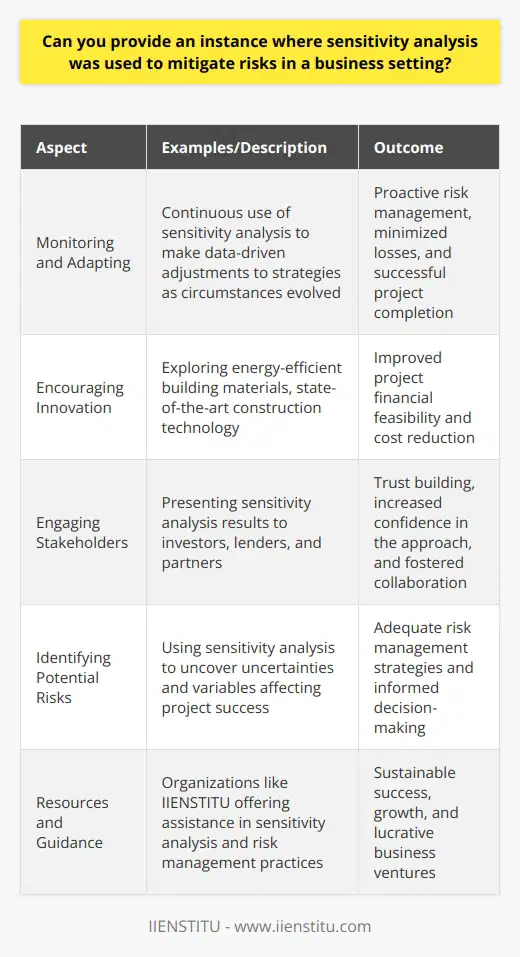
How do you explain sensitivity analysis in the context of financial modeling?
Understanding Sensitivity Analysis
Sensitivity analysis is a crucial tool in financial modeling, employed to evaluate the impact of changes in various input variables on the final outcome. Essentially, it allows for an assessment of the robustness of the model and the adaptability of different scenarios. In this context, we can explain sensitivity analysis as a technique that allows for better decision-making in finance and investments.
Assessing Variable Impacts
In financial modeling, multiple variables influence outcomes, like economic factors, market conditions, and company-specific elements. Sensitivity analysis entails altering one variable at a time while keeping other variables constant, helping to identify critical drivers and anticipate potential risks. By understanding the influence of a particular variable on an outcome, decision-makers can analyze possible scenarios and optimize their strategies.
Addressing Uncertainty
One key aspect of sensitivity analysis is addressing the uncertainty in predictions and projections. Financial models often contain varying degrees of uncertainty due to the assumptions and estimates built into them. Through sensitivity analysis, one can gauge the extent of uncertainty, thereby strengthening the credibility of the model's outputs. This allows for more informed decision-making and risk mitigation, ultimately reducing potential losses.
Scenario Analysis vs Sensitivity Analysis
Though often used interchangeably, scenario analysis differs slightly from sensitivity analysis. While sensitivity analysis modifies a single variable, scenario analysis alters multiple input variables simultaneously, emulating specific situations or events. Despite this distinction, both techniques serve a similar purpose—analyzing how different circumstances affect the performance and outcomes of financial models.
Implementing Sensitivity Analysis
To perform sensitivity analysis, a range of values or data for the chosen variable is systematically applied to the financial model, while documenting the corresponding results. Decision-makers often use graphical representations or tables to analyze these results, identifying the impact of the variable and potential risks associated with various scenarios. Sensitivity analysis, combined with scenario analysis, help cover a comprehensive array of possible outcomes, increasing the reliability of financial models.
In summary, sensitivity analysis plays a vital role in financial modeling, offering valuable insights into the influence of specific variables on outcomes, aiding risk management, and facilitating proficient decision-making. By understanding the significance and application of sensitivity analysis, stakeholders can make informed choices and optimize their financial strategies.
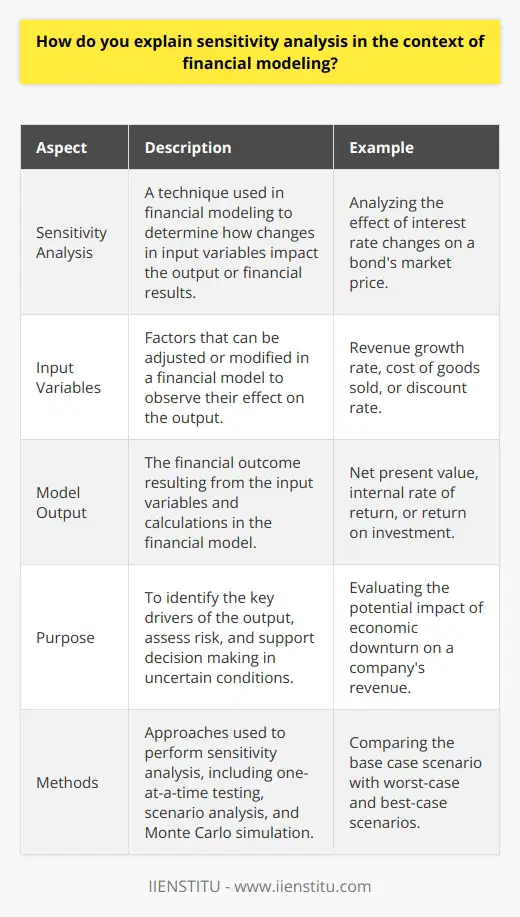
What is the role of sensitivity analysis in evaluating the robustness of a model's assumptions and forecasts?
Assessing Model Robustness through Sensitivity Analysis
Sensitivity analysis serves a crucial role in evaluating the robustness of a model's assumptions and forecasts. By altering the input parameters of a model, sensitivity analysis helps identify the extent to which changes in these parameters impact the model's outputs. This information proves invaluable in understanding the reliability and validity of a model's predictions and conclusions.
Addressing Model Assumptions
Often, models incorporate various assumptions to simplify the complexity of the underlying phenomena. These assumptions may involve approximations or generalizations, leading to uncertainties. Sensitivity analysis enables analysts to pinpoint the assumptions that significantly affect the model's performance. By doing so, it facilitates a more comprehensive evaluation of these assumptions and their potential impact on the model's forecasts.
Investigating Parameter Uncertainty
In many cases, input parameters have uncertain values derived from estimates, proxies, or expert opinions. Sensitivity analysis allows modelers to study the effects of parameter uncertainty on the model's outcomes. This process helps quantify the degree of confidence in the model's predictions, enabling analysts to identify high-risk scenarios and make informed decisions based on their findings.
Testing Model Validity and Reliability
As sensitivity analysis reveals how the model reacts to different input parameters, it provides insights into the model's validity and reliability. A model with low sensitivity to changes in input values illustrates robustness, whereas a highly sensitive model might require adjustments or refinements to improve its reliability. Moreover, sensitivity analysis allows for the identification of parameters that have little to no effect on the model's outputs, streamlining the model by removing insignificant variables.
Estimating Forecast Uncertainty
An important aspect of any forecast is understanding the level of uncertainty associated with it. Sensitivity analysis contributes by quantifying the forecast uncertainty due to variations in input parameters. This information can be communicated to decision-makers, supporting the development of robust strategies that account for potential variations in the model's outcomes.
In conclusion, sensitivity analysis plays a vital role in assessing the robustness of a model's assumptions and forecasts. By scrutinizing the influence of uncertain input parameters and assumptions, sensitivity analysis offers invaluable insights into model validity and reliability, forecast uncertainty, and opportunities for model refinement.

Can you provide an example of a sensitivity analysis scenario in a project management context?
Sensitivity Analysis Scenario
In a project management context, sensitivity analysis is a technique that demonstrates how the uncertainty in the input values can affect the resulting output or the project objectives. By identifying the potential risks and determining their impact on the project, this analysis helps project managers to make well-informed decisions during different stages of the project lifecycle. This paragraph provides an illustrative example of a sensitivity analysis scenario.
Baseline Project Plan
Consider a large-scale construction project that involves building a hospital. The project duration is estimated to be 24 months, with a total budget of $20 million. The project plan includes a detailed list of activities, required resources, and their respective allocations for each task. The baseline schedule of the project is the foundation for the project's sensitivity analysis.
Identifying Key Input Variables
For this scenario, three critical input variables may considerably impact the hospital construction project: labor costs, material prices, and project duration. Each of these factors has the potential to influence the project's cost and duration, making them crucial to the sensitivity analysis. These variables are subject to fluctuations due to market conditions, supplier issues, or unforeseen changes in project requirements.
Calculating the Sensitivity of Variables
By performing a sensitivity analysis, project managers can determine the effect of each key input variable on the project costs and timeline. For example, if the labor costs surge by 15%, the project managers can use these insights to calculate the new total cost and duration of the project. Simultaneously, they can examine the impact of potential delays or changes in material prices, thereby identifying areas of concern in the project plan.
Developing Contingency Plans
Based on the results of the sensitivity analysis, project managers can develop contingency plans to address potential challenges in the hospital construction project. For example, by identifying that labor costs pose significant risks, project managers can explore strategies to manage these costs effectively, such as hiring additional temporary staff or improving the allocation of existing labor resources. Similarly, addressing potential risks in material prices and project duration can ensure the project's successful completion within its initial scope.
In conclusion, sensitivity analysis is essential in project management, as it allows for the identification of potential risks and their impact on project objectives. By using this technique, project managers can proactively make adjustments to project plans and implement mitigation strategies, leading to improved decision-making and increased project success rates.

How do you explain sensitivity analysis in relation to evaluating different investment strategies?
Understanding Sensitivity Analysis
Sensitivity analysis is a crucial tool in evaluating different investment strategies by assessing the impacts of changes in various factors, such as market conditions or economic indicators, on the performance of a given investment. It helps investors understand the possible risks and rewards associated with different investment strategies and aids in making informed decisions.
Examining Variations in Key Parameters
In the context of investment strategies, sensitivity analysis focuses on examining the variations in key parameters, such as interest rates, inflation rates, and asset prices. By altering these parameters within a certain range, investors can determine how robust their investment strategy is against fluctuations in the market. This enables investors to identify potential weaknesses and revise their strategy accordingly.
Quantifying Uncertainty and Identifying Potential Outcomes
Sensitivity analysis quantifies the uncertainty associated with different investment strategies by constructing multiple scenarios, which are based on alternative assumptions about future market conditions or economic indicators. By comparing the different scenarios, investors can gain insights into the potential outcomes of their investments and better evaluate the feasibility of their strategies.
Assessing Risk and Investment Performance
A key aspect of sensitivity analysis is assessing the risk and performance associated with various investment strategies. It does this by calculating the changes in the expected returns, risk measures, or other investment criteria under different scenarios. By understanding the relationship between these factors and the underlying assumptions, investors can evaluate the potential risks and rewards associated with their investment decisions.
Decision-Making Tool for Portfolio Management
In conclusion, sensitivity analysis is a valuable aid in evaluating different investment strategies by providing insights into how the performance of investments might change in response to varying economic conditions or market fluctuations. By examining variations in key parameters, quantifying uncertainty, and assessing risk and performance, investors can make more informed decisions, enhance their portfolio management, and ultimately, achieve greater long-term investment success.
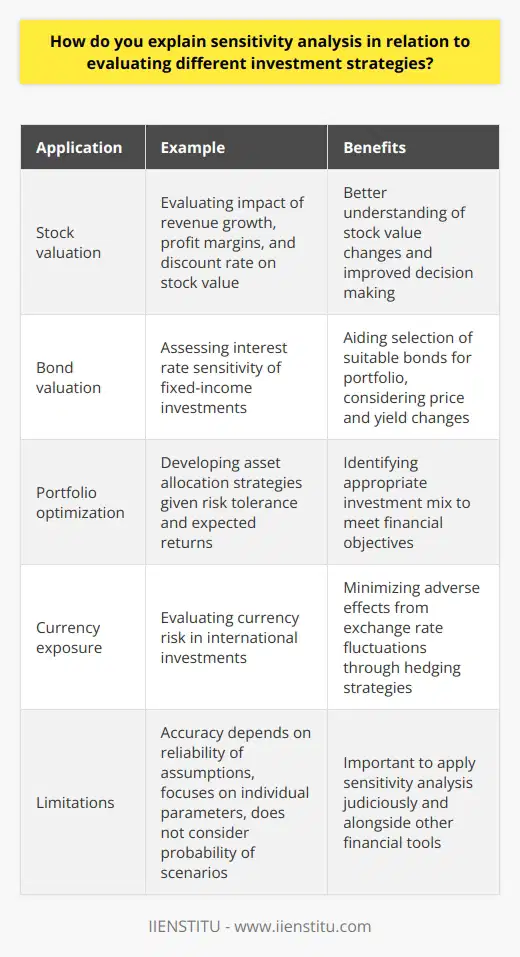
What are the key factors considered in conducting sensitivity analysis within the realm of risk management?
Factors in Sensitivity Analysis
Understanding Inputs
In the realm of risk management, sensitivity analysis involves evaluating the impact of varying inputs on a model or system's output. One key factor in conducting a sensitivity analysis is understanding the inputs, such as assumptions, parameters, and variables that directly influence the system. Identifying and comprehending the significance of each input is essential for determining which factors to prioritize during the analysis.
Establishing Relationships
Once the critical inputs are identified, the next step involves establishing relationships between the inputs and the outputs. It is essential to quantify the interactions among the inputs, as well as their individual effects on the outputs, using statistical measures such as correlation coefficients and regression analysis. This step allows analysts to evaluate the extent to which each input affects the output and provides a comprehensive understanding of the system or model's behavior.
Selecting an Appropriate Method
Several sensitivity analysis methods are available for use in risk management, each with its advantages and limitations. Among the most common methods are one-at-a-time (OAT) analysis, variance-based global sensitivity analysis, and response surface methods. The choice of an appropriate method relies on factors such as the complexity of the model, the number of inputs, and the desired level of detail in the analysis results. Selecting the most suitable method ensures the analysis's accuracy and usefulness.
Consideration of Uncertainty
Incorporating uncertainty in sensitivity analysis is crucial for capturing the inherent variability and randomness associated with different inputs. Analysts must accurately account for uncertainties in input data, such as measurement errors or variability in model parameters, to produce accurate estimates of the output's sensitivity to these input factors. Monte Carlo simulation is a commonly used technique for dealing with uncertainty in sensitivity analysis, as it allows analysts to model various possible input values based on their probability distributions.
Evaluating Model Performance
Lastly, evaluating the performance of the model or system being analyzed is a crucial aspect of sensitivity analysis in risk management. This evaluation involves comparing the system's predicted output with known or observed outputs under various input conditions. Good model performance is indicated by a close match between the predicted and observed outputs, and the system should be able to produce accurate results across a range of sensitivity scenarios. In cases where the model performance is inadequate, sensitivity analysis findings can guide model improvement efforts, ultimately contributing to more effective risk management.
In summary, conducting sensitivity analysis in the realm of risk management involves understanding inputs, establishing relationships, selecting an appropriate method, considering uncertainty, and evaluating model performance. These factors combine to ensure accurate and robust analysis results that contribute to effective risk management strategies.

Can you provide an example of sensitivity analysis application in the context of environmental impact assessments?
Sensitivity Analysis in Environmental Impact Assessments
Overview of Sensitivity Analysis
Sensitivity analysis is an essential tool for evaluating the robustness of decision-making processes in various fields, including environmental impact assessments (EIAs). This analytical method identifies key variables that significantly influence the outcomes and gauges the extent of their impact on the final results. By understanding these critical factors, decision-makers can better manage uncertainties related to environmental issues.
Example of Application in EIAs
One notable application of sensitivity analysis in the context of environmental impact assessments arises in predicting the potential effects of alternative energy projects, such as wind farms. These projects may raise concerns about their impact on bird populations, as the turbine blades may collide with flying birds or alter their habitats.
Identifying Key Factors
To conduct a sensitivity analysis, one must first identify the key variables that influence the potential impact on birds. These variables could include turbine height, rotor diameter, bird flight altitude, and sensitivity to disturbance. Additionally, data on bird species and population size, wind farm location, and proposed layout are essential for this analysis.
Analyzing Uncertainties and Variabilities
Once the variables are determined, uncertainties and variabilities within these factors must be assessed. For example, there may be uncertainty regarding the actual flight altitude of birds due to imperfect observation techniques or a lack of data. In this scenario, the sensitivity analysis investigates how varying the flight altitude within a reasonable range could potentially alter the results of the EIA.
Assessing the Robustness of Decisions
After evaluating the uncertainties and variabilities within the key factors, decision-makers can use the sensitivity analysis to assess the robustness of their choices under various circumstances. This evaluation compares the expected impacts of each wind farm design alternative by changing the key variables' values. Analyses of this nature help ensure that project designs with the least negative impact on bird populations are chosen, considering the uncertainties involved.
In conclusion, sensitivity analysis can significantly enhance the accuracy and clarity of environmental impact assessments, confirming the robustness of decision-making. By highlighting potential uncertainties and analyzing their effects on the outcomes, sensitivity analysis helps decision-makers develop better-informed designs and policies, promoting sustainable development and ensuring long-term environmental conservation.
